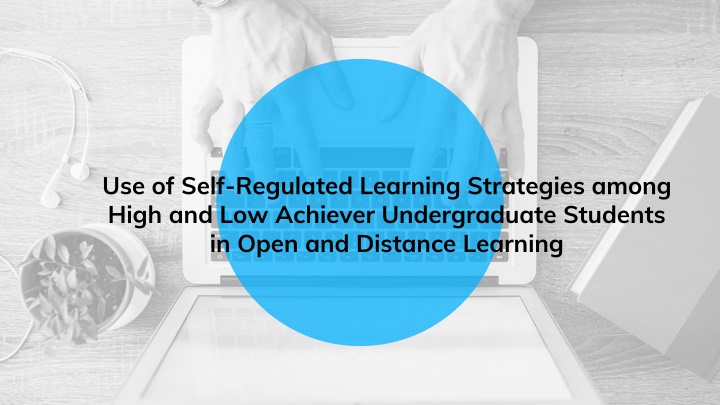
Self-Regulated Learning Strategies in Open and Distance Learning: A Comparative Study
Explore the use of self-regulated learning strategies among high and low achiever undergraduate students in an open and distance learning setting. Understand the importance of self-regulated learning in online environments, its correlation with learning achievement, and the research objectives focused on self-regulation levels among students.
Download Presentation

Please find below an Image/Link to download the presentation.
The content on the website is provided AS IS for your information and personal use only. It may not be sold, licensed, or shared on other websites without obtaining consent from the author. If you encounter any issues during the download, it is possible that the publisher has removed the file from their server.
You are allowed to download the files provided on this website for personal or commercial use, subject to the condition that they are used lawfully. All files are the property of their respective owners.
The content on the website is provided AS IS for your information and personal use only. It may not be sold, licensed, or shared on other websites without obtaining consent from the author.
E N D
Presentation Transcript
Use of Self-Regulated Learning Strategies among High and Low Achiever Undergraduate Students in Open and Distance Learning
Amina Latif Instructor Education Virtual University of Pakistan Dr. Munawar Sultana Mirza Advisor Acadamics Virtual University of Pakistan 2
What is self regulated learning? why is it important in online distant environment?
Pintrich (2000) An active and constructivist process whereby learners attempt to monitor, regulate, and control their cognition, motivation and behaviors after setting goals for their learning, are guided and restricted by their own goals and the learning environment they are in" (p. 453). 4
Background/Introduction Self Regulated learning (SRL) predictor/ correlate of learning achievement. SRL strongly related with other student relate variables e.g. motivation, exhaustion etc. which may affect their learning achievement SRL is more desired trait from students in online distant learning (ODL) settings as compared to conventional settings. 5
BIG CONCEPT Bring the attention of your audience over a key concept using icons or illustrations 6
Research Objectives To find out the use of Self- regulated learning strategies among ODL students. 2. To compare the level of self- regulation among high and low achieving students. 3. Cross discipline comparison of students for the use of self- regulated learning strategies. 4. To compare the use of self- regulated learning strategies among male and female students 1. 7
Achievement Lavel Help Seeking Goal Setting High Achievers Effort Regulation Self Low Achievers Regulation Maganging Physical environment Self Study Strategies 8
Methods Quantitative descriptive study Survey research design Questionnaire 9
Population and Sample of the Study Population BS Hons. Students 15033 Target population 2468 Sample 303 10
Population and Sample Distribution Study Program Total Enrollment Psychology 736 Sr. No. 1. Target Population 198*2=396 Sample A B C 38+18=56 Information Technology B.Ed (Hons) Elementary 1779 480*2=960 37+27=64 2. 10 20 7 Yellow 118 35*2=70 40+29=69 3. 30 889 15 240*2=480 10 Blue Business Administration Mathematics 52+8=60 4. 1041 281*2=562 27+27=54 5. 5 4560 24 2468 16 Orange Total 303 11
Kocdar, Karadeniz, Bozkurt & Buyuk (2018). Cronbach s Alpha reliability .950 Goal Setting Help Seeking Self Study Strategies Managing Physical Environment Effort Regulation 12
Comparison of high and low achieving students on sub-factors of self-regulation Ach. Level Low 140 19 High 163 19 Help Seeking Low 140 High 163 Self-Study Low 140 High 163 Physical Environment High 163 Effort Regulation High 163 Total Self- Regulation High 163 Factor N Mean SD Sig. Theoretical Range 5-25 Goal Setting 4.216 3.474 8.019 8.867 7.150 5.344 5.097 3.964 1.873 1.670 21.132 14.847 .111 25 27 29 31 23 25 7 8 103 109 .000 9-45 .119 8-40 Low 140 .209 6-30 Low 140 .659 2-10 Low 140 .002 30-150 13
Comparison of high and low achieving students for SRL within each discipline Ach. Level Low 27 Department N Mean SD Sig. Mean Difference -9.057 Information Technology 98 22.770 .057 High 37 107 14.552 Business Administration Low 8 88 27.802 .002 -20.451 High 52 108 13.916 Psychology Low 38 110 17.578 .830 -1.105 High 18 111 18.474 Mathematics Low 27 102 18.265 .206 -5.962 High 27 108 15.885 Education Low 40 104 21.885 .024 -10.514 14 High 29 115 12.934
By Gender comparison Gender N Mean SD Mean Difference Sig. Self- Regulation Score Female 153 103.464 19.049 6.335 .002 Male 150 109.800 16.885 15
Cross Discipline comparison of Students for the Level of Self-Regulation (ANOVA) Levene s Test of Homogeneity of Variances .980 No significant difference in level of self-regulation of students over the five study disciples e.g. Arts, Computer Science and Information Technology, Science and Technology, Education and Management Science. 16
Recommendations Self-regulated learning strategies shall be promoted among ODL student with a special focus to build help seeking behavior among students regarding their study needs. 18
Thanks! Any questions? You can find me at: amina.latif@vu.edu.pk 19
